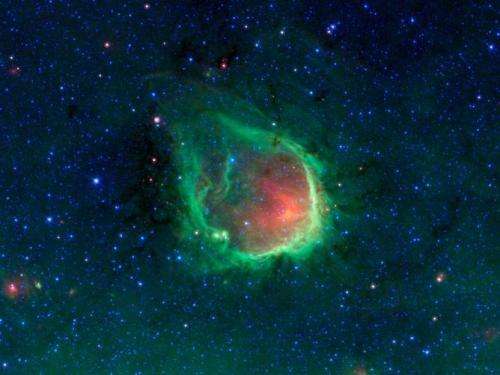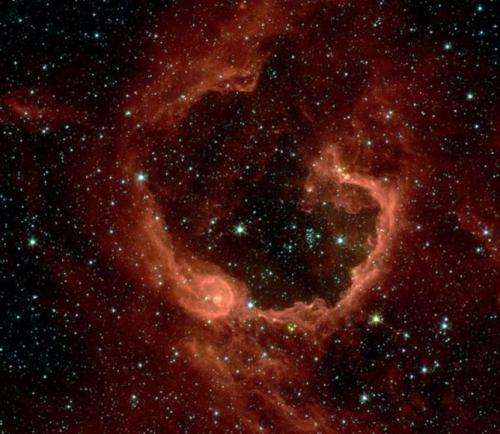Milky Way's biggest star may have had a different beginning

The current theory of star formation has a problem: it cannot make big stars.
In the standard star-making recipe, stars are formed in the depths of gas clouds made from molecular hydrogen. These clouds form the coldest part of the gas that exists between the stars throughout the Milky Way's galaxy disc. In the densest regions of the cloud, gravity presses down to form a core which then sucks on the surrounding gas until it is big enough to begin nuclear fusion.
This picture is immensely successful for forming a star like our own sun. However, try the same model with a star ten times larger and you swiftly run into problems. When a stellar core with size ambitions increases in mass, its temperature also begins to rise. As it heats from the chilly 10 K (-263 °C) to that approaching 100 K (-173 °C), gas can no longer flow onto its surface. This caps its growth. The extra heat also means the star begins to radiate energy, pushing away the surrounding material.
One way around this problem is to start with a much larger core. The boost at the beginning of the star's life would allow it to reach a higher mass before the temperature and radiation became prohibitively high. Yet, the formation of a core of the necessary size requires densities higher than those typically found inside an isolated gas cloud.
Big deal
This idea led astrophysicists to consider a new theory: what if two clouds were to collide to create a big star?
Such a violent encounter would create a strong boost in density at the point where the clouds crunch together, potentially causing a much larger volume of gas to succumb to its own gravitational force and collapse to form a massive core. This idea for triggered star formation has the backing of the theorists who predict that cloud collisions should be relatively common place events. Nevertheless, it has continued to remain on the outskirts of mainstream theories due to the simple fact that such encounters assumed to be frequent have been observed very rarely.

However, this lack of observational evidence has recently changed with new discoveries surrounding the formation of Super Star Clusters. That name is accurately descriptive. Super Star Clusters are groups of stars that are tightly packed with around 10,000 stars squeezed into a volume ten times smaller than a normal star cluster. As with high mass star formation, the creation of these objects requires a large volume of gas to collapse rapidly which is impossible to rectify with traditional star formation theories.
It was during the observations of four Super Star Clusters that Yasuo Fukui at Nagoya University in Japan spotted something important. Associated with each cluster were two clouds moving towards each other at velocities greater than 20 km/s (around 45,000 mph). At these speeds, gas would shock at the point of collision, raising the density high enough to cause the collapse of a massive object. The team concluded that these were indeed cloud collision events and this clash had been the cause of the Super Star Cluster formation (papers for this Super Star Cluster formation are here and here).
While this discovery put cloud collisions firmly on the star formation theory map, four examples were not enough to account for all high mass star formation in our galaxy. Yet, Fukui suspected the same mechanism might be in play for both Super Star Clusters and high mass stars. To prove this, his group turned to objects already well known in the astrophysical community: the Spitzer bubbles.
Beauty and the gas beast
Named after the infrared space telescope that was used to detect them, the Spitzer bubbles are full or partial rings of gas that litter our galaxy like foam in a bathtub. The most popular consensus for their origin is that they are the result of strong winds blown from a central star forming inside a cloud. This theory has three problems:
1. Winds strong enough to create such a bubble can only have been caused by a radiating high mass star, but such an object is rarely seen near the centre of the bubbles.
2. The bubble's interior often contains dust which should have been evacuated along with the gas in the outward push from the winds.
3. A fully three-dimensional bubble would not look like a ring when viewed on the sky. For a ring to appear would require not only a particular flattened cloud morphology, but also a specific viewing angle, which seems unlikely given that hundreds of bubbles are observed.
These inconsistencies caused Fukui's group to observe 52 of the Spitzer bubbles. They discovered something that cast the bubbles' origin in a whole new light. While the bubbles lacked a massive star at their centre, high mass stars were seen along the bubble wall. Not only that, but more than half the cases observed had two gas clouds associated with bubbles exactly as that seen for the Super Star Clusters.
Fukui thought it was possible these objects too could be the result of cloud collisions. But was their shape consistent with such a proposition?
To investigate this, my research group at Hokkaido University took over and ran computer simulations of cloud collisions. We confirmed what Fukui had suspected—that massive cores of gas were formed at the interface of two colliding clouds. If these clouds were different sizes, this interface became curved, showing a ring structure typical of the Spitzer bubbles.
A calculation based on the number of large gas clouds in the galaxy, the speeds of the Spitzer bubble clouds and the typical mass of stars observed in their rims gives an estimated triggered star formation rate that is very close to the observed rate. While any new theory needs to be able to stand the test of time as it faces other competing models, it does look possible that we might finally be looking at the main way our galaxy's biggest stars form.
Source: The Conversation
This story is published courtesy of The Conversation (under Creative Commons-Attribution/No derivatives).
![]()




















